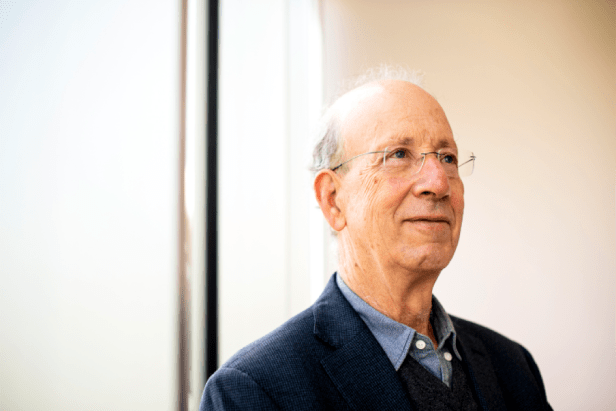Dr. Phil Brown talks PFAS contamination and ongoing research
By Laura Castañón | Northeastern University | October 23, 2019

Read the original article by Laura Castañón (Northeastern University)
“They knew something was wrong when the cows started dying.
The Tennant family kept around 200 cattle on their farm in West Virginia. But the animals began to get sick after the DuPont chemical company turned a nearby plot of farmland into a private landfill.
The case against DuPont, which was settled in 2000, would reveal that the company had been using the property to dispose of sludge containing a chemical called perfluorooctanoic acid (often shortened to PFOA or C8), which was used in manufacturing Teflon. This chemical was entering the water supply.
The massive health study that followed, involving 69,000 people, would link the chemical to kidney and testicular cancer, thyroid disease, high cholesterol, pregnancy complications, and ulcerative colitis.
The lawsuit was one of the first concerning a class of chemicals known as per- and polyfluoroalkyl substances (PFAS). And these chemicals haven’t gone away, says Phil Brown, who directs Northeastern’s Social Science Environmental Health Research Institute.
‘You have it in your blood,’ says Brown, University Distinguished Professor of sociology and health sciences. ‘Ninety-eight percent of us have it in our blood at various levels.’
Brown studies the impacts of PFAS chemicals on our health and the environment, and how communities, advocates, and lawmakers have responded to growing concerns. With a grant from the National Institute of Environmental Health Sciences, he is currently working with two communities—one in Massachusetts and one in New Hampshire—that had high levels of PFAS in their drinking water in the past few years. Research suggests that exposure to PFAS can affect the immune systems of young children, making early vaccines less effective.
Depending on the specific chemical, PFAS may clear our bodies in days or stay for years, Brown says. But they’re in personal-care and household products, food, water, and air—we’re constantly acquiring more of them. And these chemicals don’t just break down and go away. The molecules are held together by carbon-fluorine bonds—one of the strongest chemical bonds possible.
‘They’re called ‘forever chemicals’ because they stay in the environment,’ Brown says. ‘They get recycled into the food we eat and the milk we drink and the dust that we breathe, and there’s no end to how long they’re going to stay around. We’ll be constantly re-exposed to them.’
To say, ‘Let’s wait around’ is basically saying, ‘Let’s count the bodies.’
Dr. Phil Brown
There are more than 4,700 of these chemicals still being used in consumer and industrial applications to make products water-, oil-, and stain-resistant.
‘Every day we’re finding new sources,’ Brown says. ‘We knew that these were in a lot of carpets, in stain-resistant fabric. They’re in many places like pizza boxes, microwave popcorn, dental floss.’
The chemicals are also used in industrial firefighting foam—the kind used in the military and at airports.
‘They train with the real stuff and they don’t take precautions about what to do with it,’ Brown says. ‘All across the country, there are water systems full of it.’
Screenshot of the EWG+SSEHRI interactive map, showing more than 700 areas contaminated with PFAS across 49 states in the US.
Brown and his colleagues put together an interactive map of known PFAS-contaminated sites in the United States with the Environmental Working Group, a nonprofit organization that works on issues in human and environmental health.
They are also working with the Silent Spring Institute to build an online tool to help people who have had their blood or local water tested for PFAS understand their results. And Brown has a grant from the National Science Foundation to investigate how residents in PFAS-contaminated communities are responding and organizing to push for cleanups and improved legislation.
It’s a big deal… You put all this together and it’s the biggest chemical contamination issue in many, many years.
Dr. Phil Brown
People can limit their own exposure by cooking more fresh foods at home (take-out containers are often a source of PFAS), avoiding stain-resistant carpets or upholstery, using nylon or silk dental floss that is uncoated or coated in natural wax, and filtering drinking water with high levels of PFAS using activated carbon or a reverse osmosis system.
But change really needs to happen at a legislative level, Brown says.
‘We shouldn’t have to be looking at every product we buy and use,’ Brown says. ‘It should be done much further upstream. And that’s happening, so I’m actually quite optimistic that we could reduce our levels.’
The important part, he says, is to regulate these chemicals as a class, rather than individually. Otherwise, each of the roughly 4,700 chemicals would need to be investigated separately, even if they had only minor molecular differences. And since the health effects are long-term problems like cancer, these studies could take decades.
‘To say, ‘Let’s wait around’ is basically saying, ‘Let’s count the bodies,’’ Brown says. ‘We have lots of scientists and state agencies working on alternatives and substitutions. We can do this.'”
This content provided by the PFAS Project.
Location:
Topics: